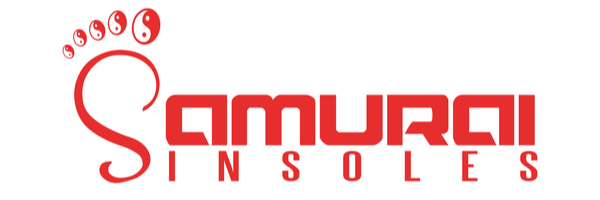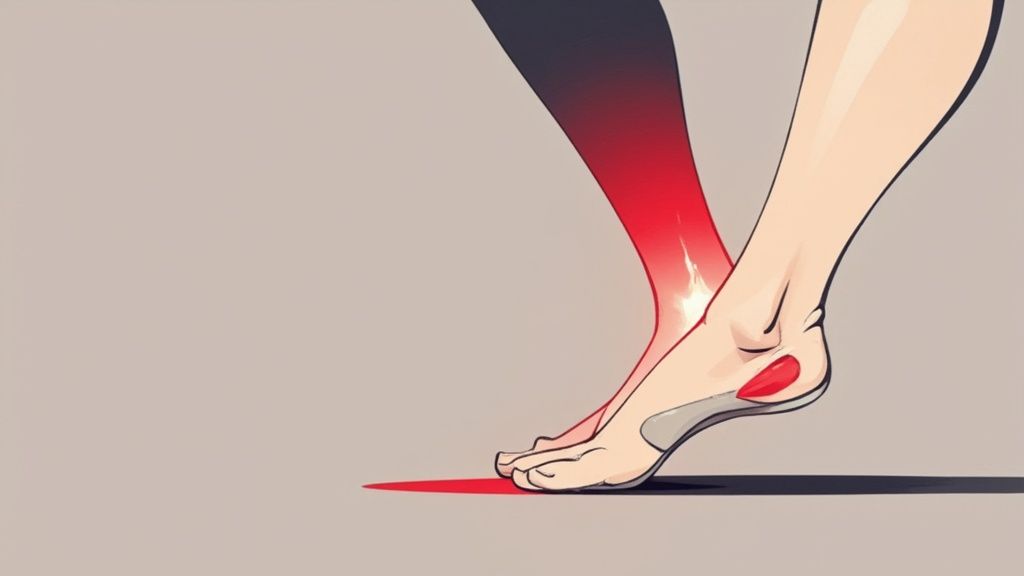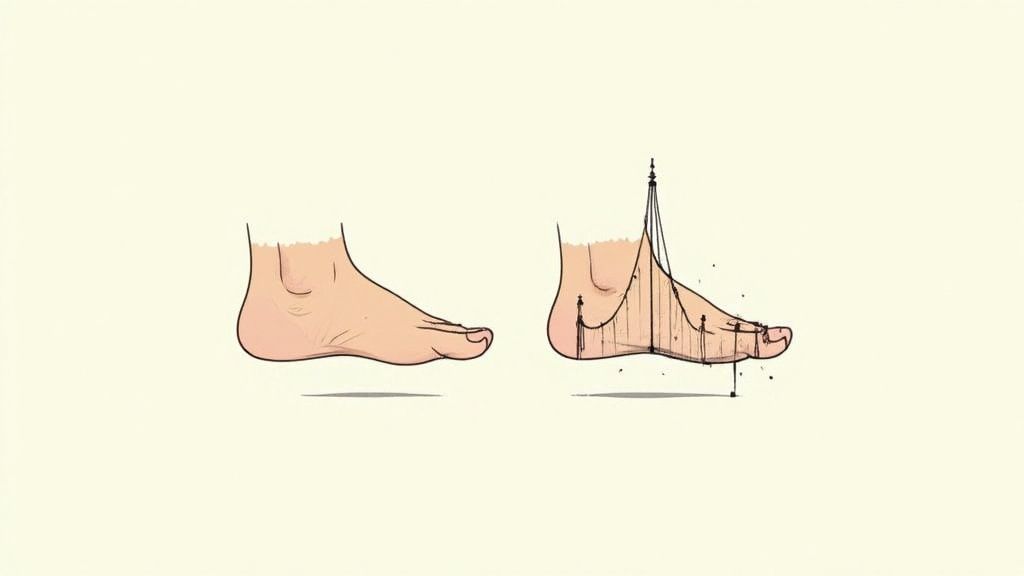Think of arch support as a simple, effective tool for your feet. It's like putting a support beam under a bridge that's started to sag. This reinforcement helps spread your weight evenly, absorbs the shock from walking, and corrects alignment problems. By propping up the arch, insoles take a ton of stress off critical parts of your foot, like the plantar fascia, which is often the key to getting rid of that nagging pain.
Why Your Feet Hurt and How Arch Support Helps
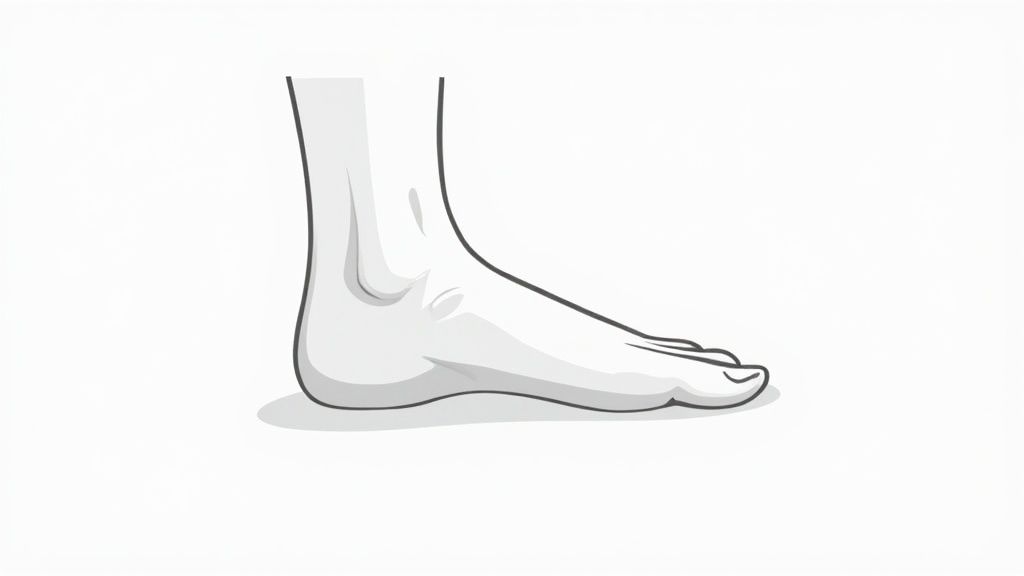
To really get why your feet are aching, picture your arch as the natural suspension system for your body. It's built to flex, absorb shock, and carry your full weight with every step. It’s an amazing piece of natural engineering, made up of a complex web of bones, ligaments, and tendons.
But just like any high-performance system, it can get worn down. Things like genetics, the constant pounding from your favorite activities, or just a lifetime of unsupportive shoes can cause this "suspension" to weaken. When the arch starts to collapse, it can no longer manage pressure the way it was designed to.
That’s when the trouble starts. This small structural failure is often the real reason behind many common foot problems. The force from each step isn't spread out correctly, leading to intense pressure on your heel and the ball of your foot.
The Breakdown of Your Foot's Natural Support
When your arch gives way, it sets off a domino effect. The plantar fascia—that thick band of tissue on the bottom of your foot—gets stretched too far and becomes inflamed. This is what causes the sharp, stabbing pain of plantar fasciitis, which is often worst first thing in the morning.
This is exactly where arch support for foot pain becomes so important. Without some outside help, your foot just keeps working in a misaligned, painful way.
- Plantar Fasciitis: This is the number one complaint from a collapsed arch, causing that telltale heel pain.
- Overpronation: This happens when your foot rolls too far inward, putting extra strain on your ankles, knees, and hips.
- Flat Feet (Pes Planus): When your arch is completely flat, your whole sole hits the ground, leading to tired, achy feet and muscles.
Your foot isn't an island. It’s the very foundation of your body. When that foundation is shaky, the problems can travel all the way up your body, causing pain and alignment issues in your knees, hips, and even your lower back.
How Arch Support Provides Relief
An arch support insole is like a custom reinforcement you can slip right into your shoe. It provides a firm, contoured platform that brings your arch back to a more natural, functional position. This is about more than just soft cushioning—it's about restoring the foot's structural integrity.
By lifting and holding the arch, an insole does three critical things. First, it immediately redistributes your body weight more evenly across the foot, taking the intense pressure off your heel. Second, it helps correct alignment problems like overpronation, guiding your foot into a healthier, more efficient motion.
Finally, it acts as a better shock absorber, soaking up the impact that travels through your foot with every single step. And this isn't just theory. An independent academic study, led by a top podiatric surgeon at Harvard Medical School, found that arch supports led to significant reductions in chronic foot pain and better balance in just four weeks. You can read the full study about these arch support findings to see the data for yourself. This simple addition to your shoe can be a powerful way to get you moving again without pain.
How Better Steps Lead to Less Pain
To really get how arch support works its magic on foot pain, we need to talk about how you walk. With every step you take, your foot naturally rolls a bit inward. This is called pronation, and it's your body's built-in shock absorption system, helping you adapt to uneven ground. A little pronation is a good thing.
The trouble starts with overpronation. This is when your foot rolls too far inward, causing your arch to collapse more than it should. Picture a car with poor alignment—it doesn't just wear out the tires unevenly, it puts a ton of stress on the suspension and frame. Overpronation does the same thing to your body, sending jarring forces up through your ankles, knees, and even into your hips and back.
An arch support acts like a gentle guide rail for your foot. It stops the excessive inward roll, encouraging your foot to move in a more neutral, efficient way. This simple correction is why a good insole can often relieve pain that seems totally unrelated to your feet.
Taming the Impact of Every Step
Every time your foot hits the ground, the ground hits back with an equal and opposite force. It's a basic law of physics called ground reaction force, and your feet are designed to handle it. But when your arches aren't doing their job, that force gets distributed all wrong, hammering sensitive spots like your heel and the plantar fascia ligament.
A quality arch support changes this dynamic completely. By providing a firm yet flexible structure under your foot, it accomplishes two critical things:
- It spreads the initial shock of impact across a much wider area of your foot, so no single point bears the full load.
- It slows down the speed of your pronation, smoothing out the motion for a more stable and controlled step.
Think of an arch support as a high-performance suspension system for your body. It cushions the landing and channels energy more effectively, protecting the delicate network of bones, ligaments, and tendons in your feet from getting beat up day after day. The relief you feel isn't just from soft padding; it's from restoring proper function.
The Proof Is in the Science
This isn't just a good theory; it’s backed by real-world results. The entire point of an orthotic insole is to correct the small biomechanical flaws that add up to significant pain. For people struggling with conditions like flat feet, getting the right support can be a life-changing experience. If this sounds like you, you can explore our detailed guide on using orthotic insoles for fallen arches to see how they help.
Medical studies have put this to the test. One major review found that orthopedic arch-support insoles delivered an incredible 75.5% improvement rate for people with common issues like plantar fasciitis. These insoles work by reducing the peak force on the heel by around 6.9% of your body weight and stabilizing your overall gait. This rebalancing is the secret to reducing pain not just in your feet, but in your lower body as a whole.
Aligning Your Body From the Ground Up
At the end of the day, the science of arch support is all about restoration. It's about bringing your foot back to its natural, optimal alignment, which allows your entire body to function the way it's supposed to. When your feet are properly supported, your ankles, knees, and hips can stack up correctly above them.
This creates a solid foundation, which improves your balance and stops you from making those little compensating movements that lead to chronic aches in other joints. Treating foot pain with proper arch support isn't just a spot treatment. It's a foundational fix that can improve your mobility, reduce fatigue, and give you a scientifically-backed way to move through life with confidence and comfort.
How to Choose the Right Arch Support for You
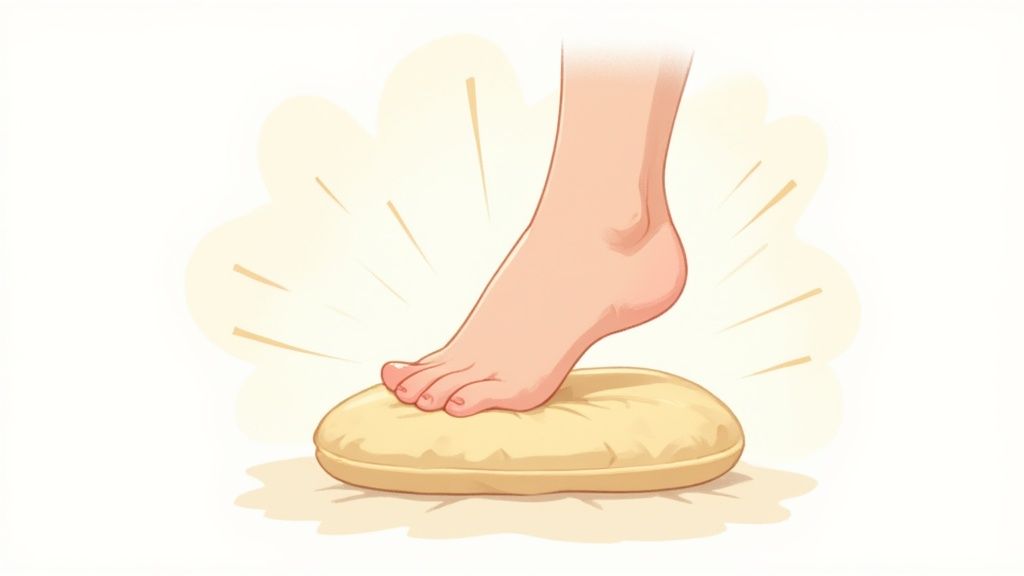
Let's get one thing straight: picking out an arch support isn't a one-size-fits-all deal. What works great for your running buddy might do absolutely nothing for you. Finding the perfect arch support for foot pain is all about matching the right level of firmness and arch height to your unique feet and your daily life.
It’s a bit like buying a new mattress. You wouldn't buy an extra-firm bed if you love a soft, pillowy feel, right? Insoles are the same. The whole point is to find that sweet spot where the support meets your specific needs, so you can finally get relief.
Assess Your Foot Type and Pain Level
First things first, you need to get to know your feet. Take a look. Do you have flat feet, where pretty much your entire sole rests on the floor? Or are your arches high, leaving a big gap between your midfoot and the ground? The shape of your arch is a huge clue for what kind of support you'll need.
Now, think about the pain itself. Is it a sharp, stabbing feeling in your heel when you get out of bed, like classic plantar fasciitis? Or is it more of a dull, throbbing ache that spreads across your whole foot after a long day? Where it hurts and how much it hurts will point you toward the right insole.
Someone with just a little bit of soreness now and then can probably get by with a flexible, cushioned insole. But if you're dealing with serious overpronation and constant heel pain, you're going to need something much more firm and structured to make a real difference.
Consider Your Lifestyle and Activities
What you do all day matters—a lot. Are you a nurse, a teacher, or a warehouse worker who spends hours on hard concrete floors? Or do you work at a desk but live for your weekend 5k runs? Your daily routine dictates the kind of support you need.
High-impact sports like running or basketball put a ton of stress on your feet. For those activities, you'll want an insole that provides serious shock absorption and firm support to handle all that pounding. The Samurai Insoles Sumos, for instance, are designed with extra foam for exactly this reason—they give you maximum cushion without collapsing under pressure.
On the other hand, for everyday walking and standing, a balanced insole like the Samurai Insoles Originals offers that ideal blend of control and comfort. And for those who need the highest level of stability, especially for severe pronation, the Samurai Insoles Shoguns have a built-in heel counter to lock your foot in place.
Decoding Firmness and Flexibility
This is probably the most important part. A lot of people think a soft, squishy gel insole is the answer to foot pain. It feels nice for a minute, but that soft cushioning usually doesn't provide the actual structure your foot needs to fix the underlying problem.
A truly effective arch support must be firm enough to resist your body weight and guide your foot back into a healthy alignment. Softness soothes, but firm support corrects.
To make this crystal clear, it helps to see how different levels of support stack up.
Comparing Arch Support Insole Levels
This quick comparison chart breaks down the different types of insoles we offer. It's designed to help you pinpoint which level of firmness and support is the best match for your feet and your lifestyle.
| Insole Level | Firmness | Arch Height | Best For |
|---|---|---|---|
| Ninjas | Flexible yet Springy | Moderate | Beginners, mild overpronation, or fitting under existing insoles. |
| Originals | Firm | Moderate to High | Everyday wear, moderate foot pain, and all-day standing or walking. |
| Sumos | Firm with Extra Cushioning | Moderate to High | High-impact activities, intense shock absorption, and severe foot fatigue. |
| Shoguns | Extra-Firm with Heel Control | High | Severe overpronation, heel instability, and maximum biomechanical control. |
As you can see, each model serves a specific purpose. The Ninjas, for example, are slim and springy, designed to slide right under your shoe's existing liner to fight overpronation without adding bulk.
Ultimately, finding the right insole means being honest about these factors. You have to match the product to what your feet are telling you. If you're just starting and want to learn more, our team put together a fantastic resource to help you out. To go even deeper, read our complete guide on finding good insoles for arch support. Making the right choice from the get-go is the key to leaving foot pain behind.
Your First Weeks with New Arch Supports

When you get new insoles, it’s tempting to slide them into your shoes and immediately go about your day. But hold on a second. Think of it like breaking in a new pair of quality leather boots—you wouldn't wear them on a 10-mile hike right out of the box. Your feet need time to adjust.
For years, your feet have gotten used to moving in a certain way, likely without proper support. Introducing a well-designed insole changes the game entirely by correcting your alignment. This adjustment period is totally normal and, honestly, crucial for getting the best results. It's all about gently re-educating the muscles in your feet.
Rushing this phase is the number one reason people give up on insoles before they even start to feel the benefits. A little patience goes a long way. Taking it slow and steady ensures the biomechanical shift is a welcome change, not a shock to your system, and makes arch support for foot pain a true, lasting solution.
Crafting Your Break-In Plan
So, what does "taking it slow" actually look like? The best approach is a simple, gradual schedule that lets your feet get comfortable with their new supportive friends.
Here’s a basic plan we recommend:
- Days 1-2: Start by wearing your new insoles for just one to two hours. Pop them out afterward and switch back to your regular shoes. Just see how your feet feel.
- Days 3-5: If everything feels good, bump it up to three to four hours a day.
- Days 6-10: Keep adding an hour or two each day. You should be working your way toward five to eight hours of wear.
- Days 11-14: At this point, you should be able to comfortably wear your insoles all day long.
This is just a guideline, not a strict rule. If you feel any real discomfort, dial it back. Listen to your body—it's the best indicator you have.
What to Expect: Normal Soreness vs. Red Flags
As your feet adapt, you might notice some mild soreness in your arches, heels, or even up into your leg muscles. That's actually a good sign! It means the insoles are doing their job, waking up muscles that have been snoozing and gently realigning your foundation. It’s a lot like the feeling you get after a great workout you haven’t done in a while.
But it's vital to know the difference between this normal adjustment and a real problem.
Sharp, stabbing, or radiating pain is not part of the break-in process. That’s a red flag. If you feel that, stop wearing the insoles and take a closer look at the fit or support level. Normal soreness feels like muscle fatigue; sharp pain is your body telling you something is wrong.
If you want to get a head start on making this process as smooth as possible, check out our guide on https://samuraiinsoles.com/blogs/articles/how-to-choose-shoe-inserts. It’s packed with tips for finding your perfect match from day one.
Troubleshooting Common Issues
A couple of minor hiccups can pop up during the break-in period. Don’t worry, they’re usually an easy fix.
-
Squeaking: Is an annoying squeak driving you crazy? It’s almost always caused by the insole rubbing against the inside of your shoe. A quick fix is to sprinkle a little baby powder or cornstarch underneath the insole. It works like a charm.
-
Improper Fit: If your insole is bunching up or sliding around, make sure you’ve taken out the shoe's original factory liner first. Samurai Insoles are meant to replace them, not sit on top (the only exception is our Ninjas). If it still feels a bit off, you can trim the toe area for a perfect, edge-to-edge fit.
By being patient and following a simple break-in plan, you’ll give your feet the time they need to truly embrace their new support and unlock a future with less pain.
It's Not Just Your Feet That Will Thank You
When you think about arch support, you're probably just thinking about your feet. That makes sense—after all, that's where the pain is. But the real benefits of good support go way, way beyond just your soles.
A great way to think about it is to picture your feet as the foundation of a building. If that foundation is shaky or uneven, you'll start to see cracks appear all the way up the walls. Your body works the same way.
When your feet aren't properly supported, they can roll inward or outward, a common issue called overpronation. This throws your entire alignment out of whack. That stress doesn't just stay in your ankle; it travels straight up your body's "kinetic chain." Suddenly, that nagging knee pain, tight hip, or persistent lower back ache might actually be your feet crying out for help.
By giving your arches the support they need, a good insole essentially shores up your body's foundation. It brings your ankles, knees, and hips back into a more natural position, taking a huge amount of strain off your joints and muscles with every single step.
The Head-to-Toe Impact of Good Alignment
Once your foundation is solid, you’ll start to notice the difference in your daily life, and fast. Fixing your foot mechanics isn't just about getting rid of pain; it's about helping your whole body work better and more efficiently. A stable base means better balance and control in everything you do.
This newfound stability can dramatically change how you move.
- Fewer Injuries: When your joints are properly aligned, they aren't twisting and torquing in unnatural ways. This can seriously cut down your risk of injury, especially in your knees and hips.
- Better Performance: With a solid base, your body generates power much more effectively. If you're a runner, your stride might feel smoother. If you play other sports, you'll likely feel more grounded and explosive.
- More Stamina: Your body uses a lot of energy just trying to compensate for bad alignment. When it doesn't have to fight itself anymore, you'll find you can stand, walk, or work out for much longer before you start to feel wiped out.
Supporting your arches is one of the smartest investments you can make in your overall health. It's not a temporary fix for your feet—it's a fundamental adjustment that improves how your entire body moves and feels, day in and day out.
Don't Just Take Our Word For It
This idea that supporting your feet helps your whole body isn't just a theory; it's backed by solid science. Many people assume they need expensive, custom-molded orthotics to see any real change, but studies are proving that high-quality, off-the-shelf insoles can be incredibly effective.
A recent clinical trial drove this point home. It found that insoles with graded levels of arch support delivered statistically significant pain reduction for people suffering from common issues like plantar fasciitis. These results show that a well-designed, accessible insole can be a powerful tool for getting your body back on track. You can see the clinical findings for yourself and check out just how effective this approach is.
It just goes to show that you don't always need the most complex or costly solution to make a real difference. Often, a simple, thoughtfully designed arch support is all it takes to start a positive chain reaction, sending relief from your feet all the way up your body and improving your comfort and quality of life.
Common Questions About Arch Support and Foot Pain
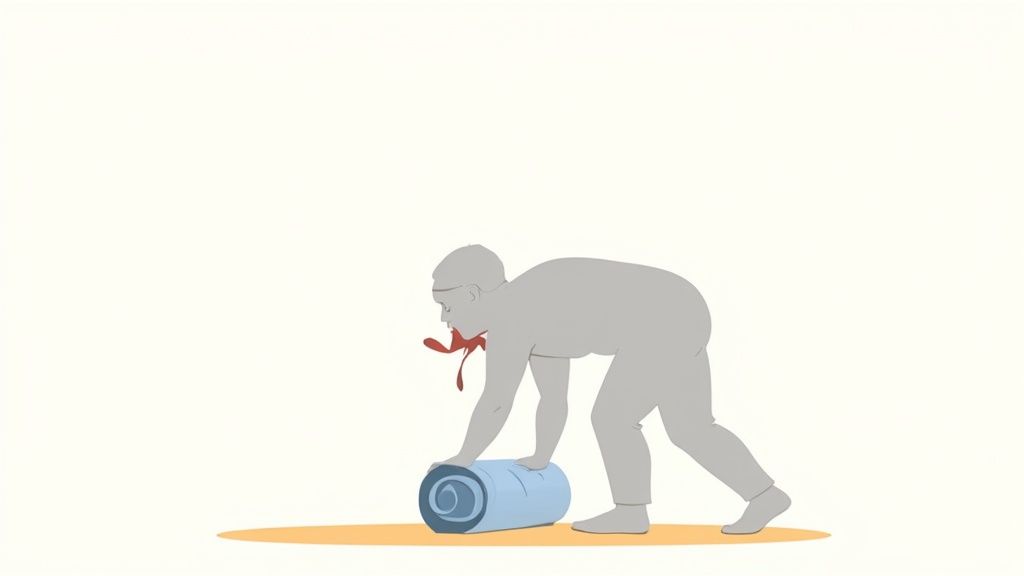
Even after seeing all the ways arch support can help, it's completely normal to have a few questions. Let's be honest, the world of insoles can feel a bit overwhelming, with all sorts of products making big promises. I want to clear the air and tackle some of the most common things people wonder about when it comes to using arch support for foot pain.
Think of this as a straightforward conversation. We'll get right to the point, giving you simple, practical answers so you can feel confident about taking the next step.
How Do I Know If I Really Need Arch Support?
The most obvious sign is foot pain that just won't go away, especially in your arches or heels. That sharp, stabbing pain you feel with your first few steps in the morning? That's the hallmark of plantar fasciitis, a condition that almost always gets better with the right support.
Another dead giveaway is looking at the bottoms of your shoes. If you notice the inner edge is worn down way more than the outside, that’s a classic sign of overpronation. It means your foot is rolling inward too much, and an insole can help guide it back into a healthier alignment.
You can also try a couple of simple at-home checks:
- The Wet Test: Get your feet wet and step onto a piece of cardboard or a dark towel. If the footprint looks like a flat oval with almost no curve on the inside, you probably have flat feet and could use some support.
- Achy Feet: Do your feet, ankles, or even your knees just feel tired and sore after a regular day? That nagging fatigue often comes from your muscles working overtime because your arches aren't getting the help they need.
If any of that sounds familiar, there's a very good chance that adding a quality insole to your shoes could make a world of difference.
Can I Use One Pair of Insoles for All My Shoes?
That’s a great question, and the short answer is: usually, yes! Most full-length insoles, like our Originals or Sumos, are designed to be moved between similar shoes. You can easily pop them out of your sneakers and into your work boots or walking shoes.
The trick is making sure the insole fits properly in each shoe—it shouldn't slide around or get bunched up. This is where it can get difficult. An insole that fits perfectly in your roomy running shoes might be too wide or bulky for a pair of snug dress shoes.
That’s exactly why different types of insoles exist. For those tighter-fitting shoes, a slimmer model like our Samurai Insoles Ninjas is the perfect answer. They’re designed to provide fantastic support without taking up too much space.
How Often Should I Replace My Insoles?
Insoles aren’t a one-and-done purchase. Think of them like the tires on your car; they do an important job, but they wear out over time. The materials that give you that crucial support will eventually get compressed and lose their spring, meaning they stop working effectively.
As a general guideline, you should plan on replacing your insoles every 6 to 12 months. But that window can change based on a few things:
- How active you are: A marathon runner or a construction worker will wear out their insoles much faster than someone who works at a desk.
- Your body weight: Heavier people naturally put more force through their insoles, which can shorten their lifespan.
- The quality of the insole: Well-made insoles are simply more durable. Our American-made Ninjas and Shoguns are built to last, which is why we can back them with a one-year warranty.
The best way to know is to listen to your body. If you start to feel those old, familiar aches creeping back in, it’s a sure sign your insoles have done their job and it’s time for a fresh pair.
What Is the Difference Between OTC and Custom Orthotics?
This is where a lot of people get confused, especially when they see the huge difference in price. Let's break it down.
Over-the-Counter (OTC) Insoles: These are ready-to-wear insoles, like ours at Samurai Insoles. They are engineered based on the biomechanics of thousands of feet to correct the most common problems, like overpronation and plantar fasciitis. A good OTC insole is an incredibly effective and affordable way to get relief.
Custom Orthotics: These are medical devices prescribed by a doctor. They are created from a physical mold or a 3D scan of your specific feet and are usually very rigid and expensive—often running several hundred dollars. They are typically reserved for people with severe or very unusual foot deformities that don't get better with standard support.
For the vast majority of us dealing with everyday foot pain, a well-designed OTC insole provides the perfect blend of support, comfort, and value. You get the relief you need without the high cost and hassle of getting custom-made ones.
Ready to stop wondering and start feeling better? The team at Samurai Insoles has designed a full range of products to tackle your foot pain directly. With our 60-day money-back guarantee, you have nothing to lose but the pain. Find your perfect pair of insoles and take the first step towards comfort today!
